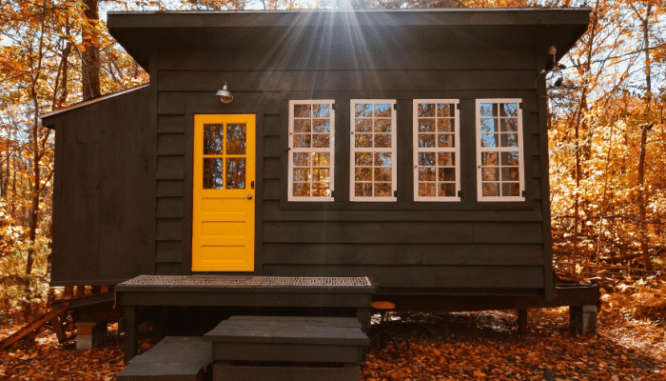Mountains, Beer, and a Laid-Back Lifestyle: Your Ultimate Guide to Homebuying in Asheville, NC
- Published on
- 5 min read
-
 Kim Dinan Contributing AuthorClose
Kim Dinan Contributing AuthorClose Kim Dinan Contributing Author
Kim Dinan Contributing AuthorKim Dinan is a writer, journalist and author. She's the outdoor news editor at Blue Ridge Outdoors and writes regularly for her local paper in Asheville, NC, covering everything from the necessity of home inspections to trends in the local economy. Kim is also the author of "The Yellow Envelope," a memoir about the time she sold her house and traveled around the globe.
Tucked into the scenic Blue Ridge Mountains, yet just a four-hour drive to the closest beach, Asheville, North Carolina, is known for its active outdoor culture and Southern charm. According to the U.S. Census Bureau, the population of Asheville has increased by 10.8 percent from 2008 through 2018. In the greater Asheville area, population is projected to hit 500,000 by 2025 — so if you’re hoping to make Beer City USA your home, you’ll face stiff competition from other buyers.
It’s easy to see why Asheville is such an attractive place to live. The city’s cute and vibrant downtown is home to over 300 locally owned shops and restaurants. Its independent spirit attracts creatives and entrepreneurs alike, and it’s been named one of the Top 100 Best Places to Live and one of the Best Places to Retire in the U.S.
We talked to experts in Asheville real estate, scoured all of the city’s most popular neighborhoods, and did the math to find the best homebuying recommendations for your budget. This comprehensive guide will tell you where and when to shop for homes in Asheville, what to know about owning a house in the mountains, and what to look out for (mold! pests!) before you sign on the dotted line.

Buying a home in Asheville? Here’s what you’ll get for your money
According to the Asheville Chamber of Commerce, in 2018 the average cost of a house was $317,502 (up from $300,227 in 2017). “Prices are up in most price ranges, particularly those under $350,000,” says real estate agent Katie Prendergast, who’s sold 87 single-family homes in the area. Prendergast also points out that homes in both Buncombe and nearby Henderson Counties are selling for 97% of their list price, on average.
For comparison, in 2018 the average cost to rent a two-bedroom apartment was $1,169. The Asheville Citizen-Times reported in June 2019 that rental prices were up 2.7% over the previous year.
For those pondering whether to rent or buy in Asheville, financing a $317,502 home at a 4.3% interest rate, and taking into account property taxes, homeowner’s insurance and a 20% down payment, a 30-year fixed-rate mortgage will run you approximately $1,623 per month as of December 2019. While that’s slightly higher than the cost of renting, homeowners build equity and enjoy appreciation on their property.
Additional costs of living in Asheville
Buyers should be aware, however, that in addition to the cost of the mortgage itself, there are also some specific considerations for Asheville homebuyers.
Because of Asheville’s location in the mountains, certain homes are susceptible to the threat of wildfires. If you are purchasing a home on a heavily wooded property, you should check to see if your homeowner’s insurance covers damages caused by wildfires. If it doesn’t, you’ll need to set aside extra money for wildfire insurance.
Some homes within city limits and many homes just outside of Asheville are on a well or septic system (or both.) Purchasing a property like this may seem like a good way to cut down on utility bills, but although you will not receive regular water and sewer bills from the city, you will want to budget for the cost of maintenance on both your septic and water filtration systems. The savvy buyer will budget approximately $450 each year for septic maintenance and about $600 for maintenance every year to the home’s water filtration system, depending on the system.
Common types of homes in Asheville
Because of Asheville’s terrain, many homes in the city are built into a mountainside. “There is daylight in the lower level,” in these types of homes, explains Prendergast. “The decks are up.” Most of these homes are made of wood and, less often, brick.
Charming bungalows are also a hit with buyers in the Asheville market. “Anywhere in Asheville where you can buy early-1900s homes that have been renovated and are all new inside but have the charm of the old feel — those neighborhoods are classic Asheville and people love them; they gobble them up,” Prendergast says. Bungalow homes like this are commonly found in hip and happening West Asheville as well as the historic Montford District.
Brick ranch homes are common throughout the city, especially in East Asheville. These homes were typically built in and around the 1960s, do not have basements, and are priced under $300,000, making them attractive to first-time buyers.
Dotted into the mountainsides that surround Asheville, buyers will find newer and larger homes constructed to maximize mountain views. These homes are typically made of wood and stone and come at a higher price point (sometimes well above $350,000).
Many buyers new to the Asheville market are surprised to find that central air is uncommon in most older homes (that’s because Asheville enjoys a fairly mild climate thanks to its elevation at 2,134 feet above sea level). Oil heating in older homes is also common, as is electric baseboard heating. While many buyers feel OK moving into homes with these outdated and less-efficient systems, others will find they need to budget for upgrading to a central heating and cooling system.

Asheville housing trends
If you’re looking for a new house with massive square footage, it may be harder to find in Asheville, where new construction is trending smaller. “People are interested in the green movement and energy-efficient homes,” says Prendergast, and that interest is leading to many new homes with a total area of under 2,000 square feet.
Prendergast also points out that a lot of folks searching for a home in Asheville are interested in purchasing a duplex or a home with a mother-in-law suite. “Rentals here are just as hot as sales,” she says.
“People can live in their house and get their mortgage paid for by short-term rentals or long-term renters while also living there.”
“It’s a great time for people who also use a portion of their property as a rental because the rental market is saturated. If you own it, you’ll be able to get top dollar for any part of your property that you’re able to lease,” Prendergast adds.
Inside of Asheville’s homes, Prendergast notes that the trends you’ll find are similar to the trends elsewhere. “Stainless steel is still in,” she says. “Hardwoods are always in. Granite is always in.” As far as paint colors go, gray and earth tones are popular.
The “upscale rustic” vibe is also popular in the homes you’ll find in Asheville. “Those sinks that look like a waterfall are popular in a mountain home,” Prendergast points out.
The advice she gives to those hoping to purchase a home outfitted with the latest trends is to “go to Lowe’s and see what is selling and you will see what is in.” If you want to swing by to check out the latest styles, there are two Lowe’s in Asheville (89 S Tunnel Road and 95 Smokey Park Highway — both stores are open 6 a.m. to 9 p.m. Monday through Saturday and 8 a.m. to 7 p.m. Sunday). Prendergast also recommends visiting popular websites like HGTV and Pinterest in order to stay abreast of popular trends.

Getting to know Asheville’s neighborhoods
The city of Asheville is divided into six sections: downtown, West Asheville, North Asheville, South Asheville, and East Asheville. Additionally, there are many small towns just outside of the city that buyers have been flocking to. Each piece of the city has its own unique vibe.
In downtown Asheville, you’ll find townhomes and condos in mixed-use buildings popping up. The appeal of downtown living is walkability and accessibility to the city’s 300 locally owned shops and restaurants.
West Asheville is one of the city’s hottest markets. The neighborhood has a hip, artsy vibe. The homes you’ll find in West Asheville are typically smaller bungalows, many within walking distance to West Asheville’s popular shops and restaurants on Haywood Road. Carrier Park, the city’s riverside park, is located in West Asheville, as is the River Arts District, home to dozens of art studios and galleries.
North Asheville is home to much of the city’s “old money.” This area of the city has Beaver Lake, a beautiful lake with a popular walking and running path, surrounded by stately homes. The Country Club of Asheville golf course is located here. The main thoroughfare, Merrimon Avenue, has restaurants, shops and grocery stores. The city’s only college, UNC Asheville, is also located in North Asheville.
South Asheville is located near Asheville’s most popular tourist attraction: the Biltmore Estate. Just outside the gates of the famous Biltmore is Biltmore Village, a walkable “urban village” designed to look like an old-world style European hamlet.
East Asheville is close to the Asheville mall and other large box stores, including the city’s only Target. This area of the city enjoys quick access to many of the city’s shops and services. In East Asheville it is typical to see many brick ranches for sale.
Prendergast says that there are a lot of hot pockets in Asheville right now. Retirees are attracted to communities north of Asheville, like the small town of Weaverville, located just seven miles north of the city. “Retirees aren’t looking for the home perched on top of the mountain,” she says, “because they’re more concerned about safety and drive time and being closer to town.”
Families, says Prendergast, are often motivated by school district. “We have a ton of great schools in this area,” she says. “People love Glen Arden district, Glen Marlow district — and Avery Creek is popular.”
Buyers beware: Here’s what to look out for when buying a house in Asheville
Asheville receives an average of 44 inches of rain each year (that’s higher than the national average of 38 inches of rain annually). In the spring and summer months there’s also humidity. The wet and muggy climate makes the perfect conditions for mold to grow.
Dampness and humidity specifically can cause a lot of problems with homes in Asheville, says Rick Bayless, founder of A Healthier Home. Bayless is a qualified environmental home health investigator and a home health, mold, and energy instructor at Blue Ridge Community College. His company has won multiple “Super Service” awards from Angie’s List.
“Seventy-five percent of what I end up dealing with environmentally is because of dampness and humidity that has been allowed to persist,” says Bayless. To combat this common problem, Bayless advises searching for a home with well-functioning and well-maintained systems and making sure the systems are the right fit for the home (the air conditioning unit shouldn’t be too large, for example, because that causes excessive dampness in the home.)
Radon, an invisible gas that causes lung cancer, is also prevalent in homes in Asheville. For that reason, radon testing is recommended before buying.
Other common problems that Bayless sees often are rodents, problems with drainage (especially gutters, downspouts, and drains), troubles with the central air conditioning and crawl spaces, excessively drafty houses, and odors. “Odors are a symptom that warrants further investigation,” Bayless points out.
While rare, Bayless also warns of more “modern issues” that homebuyers might run into, like basements that have seen “meth cooking or growing marijuana.”
While it is absolutely prudent to hire a home inspector, Bayless tells buyers to look for early signs that something is happening behind the scenes. “Look for warping or distortion or cracking or peeling or discoloration,” he says. Bayless tells buyers to “take a mouse’s-eye view” of the home they are interested in buying. “Your eyes are five feet off the ground,” he says. “You miss the stuff at ground level, where there is the earliest signs of an issue.”

The best time to buy a house in Asheville
Unlike other parts of the country where real estate markets are affected by harsh winters, Asheville sees a pretty even-keeled market throughout the year thanks to its moderate climate, Prendergast says.
“We see perks to buying in every season,” she says. “In November and December overall listings are down but so are buyers, so if you’re looking at it from a competitive standpoint, I’m buying in the winter months.” In the spring and throughout the summer and fall, more options become available, but competition increases as well.
Prendergast says that the market is “a pretty competitive game.” Smart buyers, she says, are coming into middle and lower price ranges (under $350,000), recognizing the state of the market, and making full-price offers. “Sometimes getting the best deal means that you got the house,” she says. While it’s possible to find a deal here or there on a home with a strange floor plan, for example, Prendergast points out that there are so many investors in Asheville ready to scoop up unpopular properties that nearly all homes sell for market value.
Find a top buyer’s agent in Asheville
The real estate market is hot in Asheville, and if you want to snag the house of your dreams, it’s imperative to work with a top real estate agent. Hiring a buyer’s agent will help you move quickly when your perfect home hits the market, and an agent who is well versed in your market can help you understand if you should come in with a full price offer or if there’s a bit of wiggle room. Plus, a top buyer’s agent can save Asheville buyers an average of $55,095.
“In this market where inventory is noticeably low, buyers become experts in the micro-market that is their price range,” says Prendergast. “When you see that there are only five or six homes that match your criteria and something hits the market and it’s the best thing you’ve seen in your price range, you want to make an offer and make it now — because you’d better believe that other buyers are going to see the same thing.”
Ready to buy a home in Asheville? Head over to HomeLight to find a top real estate agent in Asheville.
Header Image Source: (Sean Pavone/ Shutterstock)
